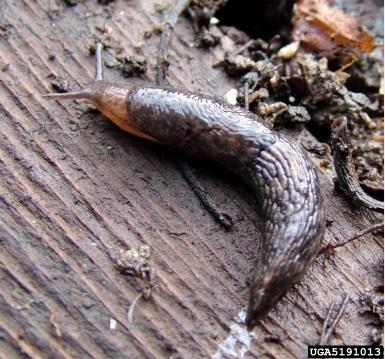Biology
Slugs, like snails, are land-dwelling mollusks that can be pests in strawberry fields. Several species of pestiferous slugs are present in North Carolina. Fully-grown slugs measure between one and six inches long, depending on the species. Slugs are hermaphroditic, meaning the same organism has both male and female reproductive organs, although their male organs usually mature before their female ones. Eggs are laid in a sheltered location in the spring or fall, and eggs laid late in the fall will overwinter before hatching the following spring. After hatching, slugs can take four months to a year to mature depending on the species and weather conditions. Slugs are incredibly sensitive to drying out and will seek shelter during the day to retain moisture. Wet weather promotes slug reproduction and survival.
Damage in Strawberry
Slugs are primarily a pest of ripe strawberry fruit and will produce holes that render the fruit unsellable. This damage is also thought to encourage additional damage by secondary pests such as beetles, sowbugs and earwigs. Slugs also occasionally feed on the leaves of strawberries causing ragged holes on the foliage. Small slugs will sometimes rasp pits in the surface of the leaf. Slug damage usually occurs at night, and dried slime trails frequently accompany it.
Sampling
The nocturnal habits of slugs can make them difficult to find. Traps can be placed in a field to confirm the presence of slugs. These traps can consist simply of boards placed in the field that the slugs will shelter underneath or cups/bowls of beer or yeast/sugar solution placed in the soil with the rim of the cup at ground level. Trapping alone rarely provides enough control to reduce damage to the crop.
Management Options
Cultural
Removing places where the slugs can shelter during the day, such as tall weeds, piles of wood, metal, or rocks and fallen trees, can greatly reduce their numbers. Maintain adequate, but not excessive moisture in plantings.
Conventional Molluscicides
If necessary, baits can be used to control slugs. Baits are most effective in the spring and fall when the slugs are mobile and looking for food. Metaldehyde-based baits, which work primarily by dehydrating slugs, can have reduced efficacy during rainy periods. Refer to the North Carolina Agricultural Chemicals Manual for materials recommended for use against slugs in North Carolina and the Southern Region Small Fruit Consortium Strawberry IPM Guide for regional recommendations. For other states check with your local extension agent.
Organic Molluscicides
Several iron phosphate-based slug baits are approved for organic growers. Refer to the North Carolina Agricultural Chemicals Manual for materials recommended for use against slugs in North Carolina and the Southern Region Small Fruit Consortium Strawberry IPM Guide for regional recommendations.
Edited from original document by Pedro Cajamarca.
More Information
Snails and Slugs – NC State Entomology Insect Notes
North Carolina Agricultural Chemicals Manual
Strawberry IPM Guide – Southern Region Small Fruit Consortium
Publication date: May 13, 2014
N.C. Cooperative Extension prohibits discrimination and harassment regardless of age, color, disability, family and marital status, gender identity, national origin, political beliefs, race, religion, sex (including pregnancy), sexual orientation and veteran status.

